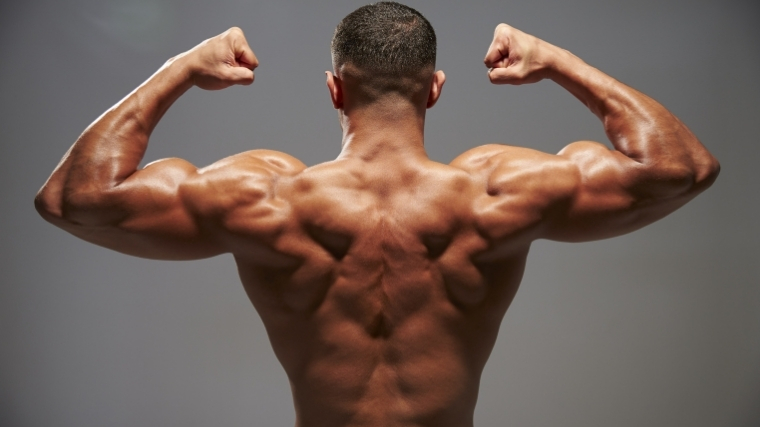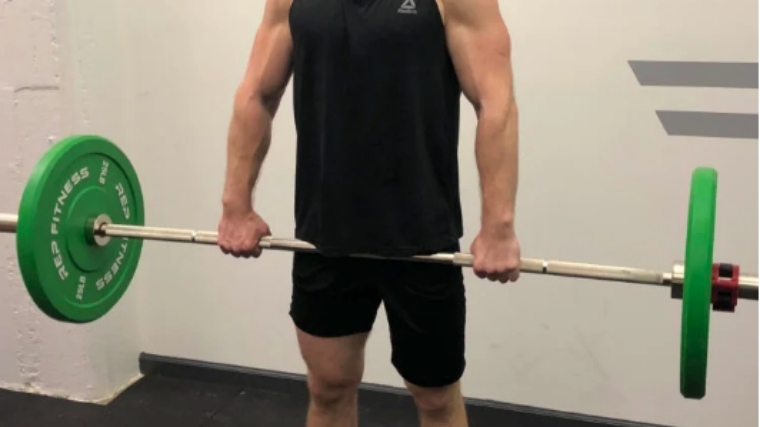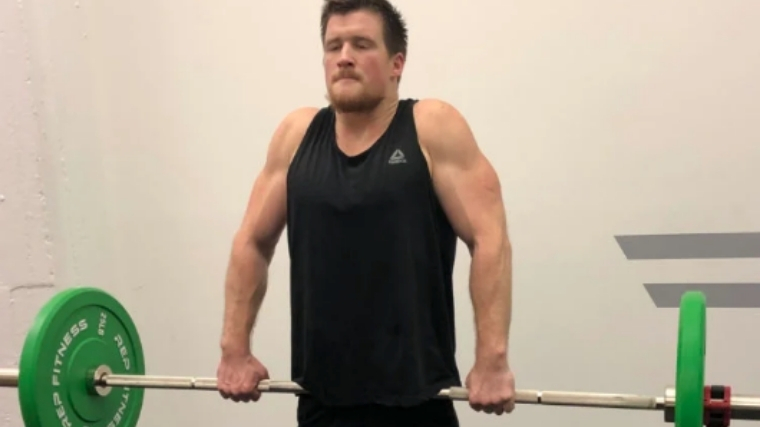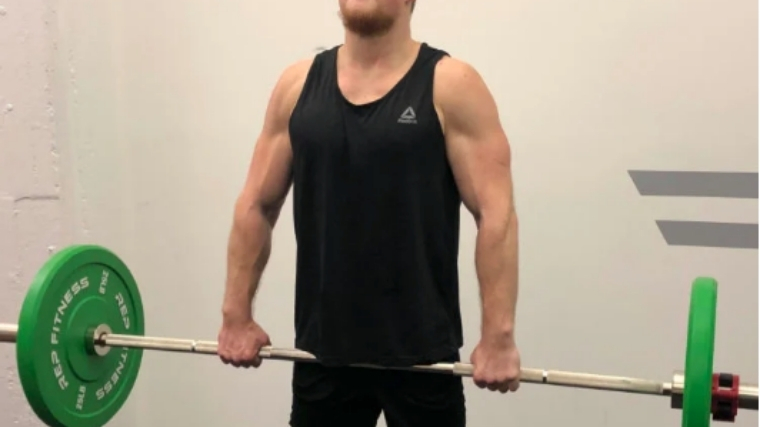Well-developed traps don’t only make you look jacked. They also play a crucial role in deadlifting, squatting, carrying, and in the Olympic lifts. The shrug is an excellent exercise for building the traps. Whether you need big traps for your physique goals or to improve your performance in your main lifts, the shrug is a great addition to your program.
In this guide, we’ll cover everything you need to know about the shrug, including how to do them with perfect technique, as well as variations, alternatives, and programming recommendations.
- How to Do the Shrug
- Benefits of the Shrug
- Muscles Worked by the Shrug
- Who Should Do the Shrug
- Shrug Sets, Reps, and Programming Recommendations
- Shrug Variations
- Shrug Alternatives
- Frequently Asked Questions
Editor’s note: The content on BarBend is meant to be informative in nature, but it should not be taken as medical advice. The opinions and articles on this site are not intended for use as diagnosis, prevention, and/or treatment of health problems. It’s always a good idea to talk to your doctor before beginning a new fitness, nutritional, and/or supplement routine. None of these supplements are meant to treat or cure any disease. If you feel you may be deficient in a particular nutrient or nutrients, please seek out a medical professional.
How to Do the Shrug
The shrug provides maximum benefit when done under control and with great technique. Here’s how to shrug safely and effectively.
Step 1 — Set-Up
Grab the bar with your hands just outside of your thighs. Optimal grip position will vary depending on your unique anatomy. Experiment with your grip position until you find what’s comfortable. Typically, it’ll be around shoulder width.
Form Tip: Shrugs can be done with the bar resting on pins or first deadlifting the barbell off the floor. If working with pins, set the pins at about mid-thigh height so that you only need to move a small distance to pick up the bar and put it down when you finish your set. Make sure that the pins are low enough that you can perform your shrugs with a full range of motion without the barbell touching the pins during your set.
Step 2 — Shrug the Bar
Drive your shoulders straight up towards the ears. Hold the top position of the shrug for a brief moment. Keep your head and legs still and avoid any swinging or “body English” type movement. If you can’t get your shoulders to their maximum height and hold that position for a moment, that’s a sign that you are using too much weight. A small amount of elbow bend to create optimal shoulder position is fine. Avoid actively lifting the weight with your elbows.
Form Tip: Use a hook grip or lifting straps as needed if grip strength is a limiting factor for your shrug performance.
Step 3 — Lower the Bar
Lower the bar slowly and under control as far as you can. You should feel a stretch in your traps as the bar reaches the bottom position.
Form Tip: Think about pushing the bar down to ensure you’re getting it as low as possible.
Benefits of the Shrug
The main benefit of the shrug is that it helps build big, strong traps, but that’s not all. Here are the main benefits of the shrug.
Improved Upper Back Strength
Any serious lifter knows that a strong upper back is crucial for reaching your full potential on deadlifts and for building a strong shelf for the bar in back squats. For deadlifts, a stronger upper back allows you to maintain a neutral spine. For the bench press, it creates a more stable base from which you can press from. And for the squat, you can better rest a barbell on your traps for stability.
Improved Olympic Lifting Ability
An explosive shrug in both the clean & jerk and the snatch helps ensure a vertical bar path and allows the lifter to reach full extension. Therefore training the shrug directly can help improve overall performance in the Olympic lifts.
Stronger, More Stable Neck Muscles
Contact sports like American football, rugby, hockey, or combat sports require an elite level of neck strength to prevent injury. Shrugs can be used as part of a comprehensive neck strengthening plan for contact sport athletes who need a strong and stable neck.
Improved Physique
Shrugs are one of the best ways to make your traps grow. Big, strong traps help create the appearance of a muscular frame that many lifters are seeking.
Muscles Worked by the Shrug
Here are the muscles that are targeted by the shrug.

[Related: The Best Supplements For Bodybuilding]
Upper and Mid Trapezius
The upper traps are the primary muscles used in the shrug, with the mid trap involved as a secondary contributor. In addition to elevating the shoulder, the upper traps support the shoulder girdle against downward forces during heavy lifts like deadlifts and farmer’s walks.
Levator Scapulae
The levator scapulae elevate the scapula, another way of saying that it shrugs the shoulders. The shrug directly targets this muscle.
Upper Back and Shoulder Stabilizers
Muscles such as the rhomboids and muscles of the rotator cuff work to help maintain a strong shoulder position by resisting the forward and inward pull of the bar during the movement.
Forearms
Anytime you grip and lift a barbell, you train your grip. The shrug is no exception. If grip becomes the limiting factor in shrugging performance, lifters should use a hook grip or lifting straps to ensure that the traps are being trained effectively.
Who Should Do the Shrug
The shrug has the potential to benefit many different types of lifters and athletes. Here’s who can benefit from using shrugs in their program and how.
[Related: What You Need to Know About How to Build Muscle]
Strength and Power Athletes
Having strong upper traps helps with squatting, deadlifting, and pressing. Directly targeting the traps with shrugs at least some of the time can help strength athletes reach their full potential in their main lifts.
Bodybuilders and Physique Athletes
The shrug is an excellent exercise to make the upper traps grow. If hypertrophy of the upper traps is a goal, the shrug is a must. Relative newcomers to the weight room, those who have been training for a year or less, can expect their traps to grow from exercises like deadlifts and carries and may not need to invest time on the shrug. For intermediate and advanced lifters looking to take their physique to a new level, the shrug is an obvious choice.
General Fitness
The shrug has fallen out of favor amongst many personal trainers. There are concerns that most people are upper trap dominant due to poor postural patterns and that the shrug will only compound this problem. Although posture is important and upper trap dominance is common, shrugs can actually help improve posture. (1) The eccentric or lowering phase of the movement provides an often much-needed stretch to the upper trap. This can have a therapeutic effect when done as part of a well-designed strength training routine.
Shrug Sets, Reps, and Programming Recommendations
Looking to include traps into your routine? Here are three set and rep suggestions. Remember that these are just that — suggestions. Feel free to play around with these sets and reps to fit your specific goals better.
To Increase Strength
To increase strength, aim to perform four to six sets of five to 10 reps, resting two minutes between sets. Strength training typically occurs in the one to five rep range, but the weight you’ll need to lift to reach that range will inhibit your form. Also, remember that the traps also get a lot of stimulus in that rep range from heavy deadlifts and presses.
To Build Muscle
This is where the shrug is the most effective. Complete three to six sets of 10 to 20 repetitions. Rest for one to two minutes between sets. Time under tension helps create muscle growth, so controlling the eccentric or lowering phase of the movement and working through the full range of motion will help you get the most out of your efforts.
To Increase Power
Training shrugs directly can help increase power in your upward pull for useful carry-over to Olympic lifting performance. Complete three to five sets of three to eight reps, resting 90-120 seconds between sets. If power is the desired goal, the power or jump shrug is the best shrug variation to use. To do these, you shrug the weight but engage in triple extension to drive the bar up off your hips, as if you will engage in a snatch or clean & jerk.
Shrug Variations
Shrugs are an accessory exercise that is particularly effective for driving hypertrophy in the upper traps. Although you can do shrugs to increase upper trap strength, power, or endurance, some of the shrug variations and alternatives covered in the next section might be the more effective choice.
Kettlebell or Dumbbell Shrug
The principal benefit of kettlebell or dumbbell shrugs is that it allows the lifter to work with the hands at the sides rather than in front of you as required when working with a barbell. Training the traps at different angles can help develop strength and hypertrophy, and it may be a more shoulder-friendly option for some lifters. Also, you’ll inherently use less weight, so, in the long run, these are a more joint-friendly option.
[Related: The Best Home Gyms For the Money, Bodybuilding, and More]
Wide-Grip Shrug
Shrugs can be done with a narrow or a wide grip. This is a useful technique for training the muscles worked in the shrug at different angles. You can use different positions to increase transfer to specific activities. For example, if you are using the shrug to improve your pull in the snatch, a wide-grip or snatch-grip shrug will have a higher degree of transfer. It might also help athletes find the optimal position for them to work on shrugs. The exact best position for you does depend somewhat on your unique anatomy. If a wider grip helps you get a better mind-muscle connection or a good pump, that’s a good sign that the wider grip variation works better for you.
[Related: Build Your Own Iron Paradise With These Home Gym Essentials]
Power Shrug
The power shrug is a component of the clean & jerk or snatches that involves first producing force with the lower body starting in a power position and then also explosively shrugging the bar. This variation involves only the shrug and not a pull seen in the clean pull or snatch pull. This exercise can help develop the skill of transferring power from the lower body to the upper body and specifically developing power in the traps. This variation can help improve Olympic lifting technique and performance.
[Related: What Are Workout Splits and Which Is the Best One?]
Shrug Alternatives
If you’re looking to swap traps out of your program, try one of these three exercises out.
Deadlifts
In addition to elevating or shrugging the shoulder, the traps help support the shoulder girdle when the arms are holding a heavy barbell as they do in the deadlift. Deadlifts provide plenty of stimulus to the upper traps for many lifters, particularly beginners. Deadlifts are also a great option for stimulating the traps with high amounts of force and working in a lower rep range, rather than going extremely heavy with shrugs. Many powerlifters will have highly developed traps, yet they don’t do shrugs. This is a testament to the efficacy of the deadlift for developing the traps.
[Related: What to Know About Strength Training For Bodybuilders]
Farmer’s Carry
The Farmer’s carry and other heavy carry variations train the traps similar to the deadlift. The traps work to support the shoulder girdle against the downward pull of the weight in the hands. The farmer’s carry also develops total body strength, dynamic hip stability, grip strength, and body conditioning. If you want to get some extra work on your traps but also tick a few other important training boxes at the same time, the farmer’s carry is a great choice.
[Related: The 7 Best Back Exercises For Strength and Muscle Gain]
Rows
The upright row involves elevation of the shoulder and significant activation from the upper trap. Seated and bent-over row variations develop the mid trap. Although the upright row is somewhat controversial, it can be done in people with otherwise healthy shoulders, and modifications can be made to make it safe. (2)
[Related: Nail the Pull-Up For Back Muscle, Strength, and Full-Body Potential]
FAQs
When should I do shrugs?
The shrug is an accessory exercise that’s best done towards the end of your session after your main lifts are completed. You likely do not need to train shrugs year-round. Rather you can include them in your program some of the time for additional strength and size in the traps. Traps recover quickly compared to other major muscle groups to be trained multiple times per week without issue for most lifters.
Should I do a strict (regular) shrug or a power shrug?
It depends on why you’re putting shrugs in your program. If you’re looking for big, well-developed traps, a strict shrug will provide better results because of increased time under tension and mind-muscle connection. If you are using the shrug to compliment your Olympic lifting, a power shrug is the better choice.
Should anyone avoid shrugs?
There is a trend within the general fitness world to avoid the shrug because many people are upper trap dominant due to prolonged sitting with poor posture. When used as part of a well-balanced training routine, the loaded stretch component of the shrug may actually help individuals with this postural pattern. As long as you can do this exercise comfortably and without pain, there’s no need to exclude it from a person’s training program.
References
- Ji-Hyun L, Heon-Seock C, Woo-Jeong C, Hyo-Jung J, Tae-Lim Y. Various shrug exercises can change scapular kinematics and scapular rotator muscle activities in subjects with scapular downward rotation syndrome. Hum Mov Sci. 45:119-29, 2016.
- Shoenfeld, B, Kolber M, Haimes J. The Upright Row: Implications for Preventing Subacromial Impingement. Strength and Conditioning Journal: 33: 25-28, 2011.


